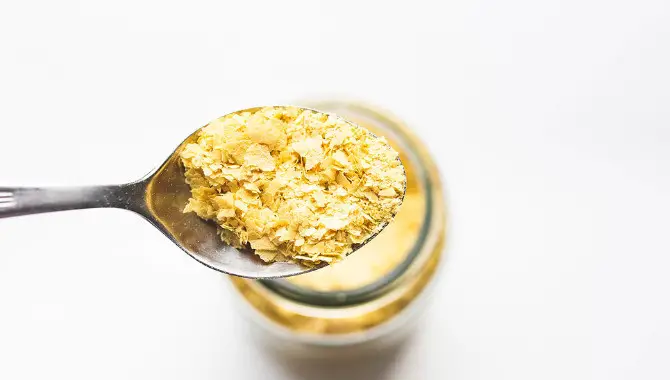Nutritional yeast is sometimes called “vegan Parmesan” due to its cheesy umami flavour. Others give it the affectionate nickname of “nooch”. It’s made from inactivated yeast that comes in flakes or powder form and can be added to vegan recipes to give them a little more kick. It also has some useful B vitamins.
Although it’s popular, though, not everyone is keen on nutritional yeast. Some just don’t like the flavour while others are on yeast-free diets that require abstaining from nooch. Luckily, there are plenty of tasty alternatives that can be used instead.
What is a substitute for nutritional yeast? Anything that provides additional flavour, especially umami flavours. You can substitute a different kind of yeast, such as brewer’s yeast. You may also want to substitute with yeast-free ingredients such as herbs, spices, vegan soy sauce, bean flour or dried mushrooms. The nutritional content can be replaced with other foods or supplements.
If you’ve landed on this page, you obviously have questions about nutritional yeast replacement and what you can use as substitutes for nutritional yeast. Maybe you’ve recently embarked on a yeast-free diet and need something to replace nutritional yeast in your recipes. Perhaps you’ve found a great recipe you want to try but you’re all out of nutritional yeast today. Maybe you just want some variation in your meal plans.
- What can you use instead of nutritional yeast?
- Where can you get the same vitamins that are found in nutritional yeast?
- Will other types of yeast work instead?
Read on to find out more about sub for nutritional yeast.
Worth Watching Video:
What is a substitute for nutritional yeast?
In terms of flavour, pretty much anything with a savoury, umami kick can stand in for nutritional yeast. If you can’t get your hands on the nutritional yeast suggested by your cookbook, there are plenty of good solid alternatives that will taste just as good. My personal go-to if I’m temporarily out of nooch is a dash of dark soy sauce. This gives my food a delicious savoury taste without requiring nutritional yeast.
Another great alternative to nutritional yeast is yeast extract. The brands most people are familiar with are Marmite, and its slightly milder Australian cousin, Vegemite. Personally I love both of these and will happily eat them every day but I can imagine some readers cringing a little. If you’re not a Marmite lover, hear me out. Even if you don’t care for the taste of yeast extract in its unadulterated state, small quantities blended into food don’t have the intensity that many find offputting. Instead, they impart a pleasantly savoury flavour that rounds out many dishes. Be aware that most yeast extract products are high in salt so they tend not to be great for lower-sodium diets.
You could also try brewer’s yeast instead of nutritional yeast. You’ll need to use rather more — I find that I need roughly double the suggested quantity of nutritional yeast if I’m using brewer’s yeast instead. If the recipe calls for a tablespoon of nooch, I throw in two spoonfuls of brewer’s yeast. You’ll also find that the taste is slightly different. Brewer’s yeast is a little more bitter, though not unpleasantly so. It can make a pleasant change if you’re more accustomed to yeast extract or nooch.
Another well-loved standby for the vegan kitchen is vegetable bouillon and stock. These are broadly similar — the rich essence of vegetables, simmered and boiled down to make an intensely flavourful concentrate. You can buy this as a liquid in cartons, which I find the best-tasting. Obviously you will need to tweak the liquid content, since the bouillon will contribute a significant amount of extra fluid and the dry yeast flakes won’t be there to soak up the juice. Stock and bouillon cartons are best for things like soups or stews — any recipe that calls for a lot of liquid.
If your dish calls for less fluid, you can use a concentrated bouillon or a stock cube instead. Stock cubes tend to be a bit less tasty but they can be used when you don’t want to add too much liquid to a dish. Most bouillon and stock products are high in salt but you can find low-sodium varieties. Be aware, if you’re avoiding yeast, that a lot of these prepared stocks will contain yeast extract as a flavouring. You can find yeast-free stock or make your own.
There are lots of herbs and spices you could try instead of nutritional yeast. Be generous with your spices and don’t store them for too long — they tend to lose their flavour. We’ll go into some more detail later in the article.
Dried mushrooms as a nutritional yeast substitute
Another nutritional yeast substitute I really enjoy is made from dried chopped mushrooms. There are lots of different varieties, each with their own unique characteristics. You can buy ready-chopped dried mushrooms but I prefer to buy them whole. I find the flavour keeps better if you buy whole dried mushrooms and then chop or grind them as you need them. In the next section, we’ll look at some of these.
While you don’t need a reason why to become vegan, one common motivation is health. Dried mushrooms line up neatly with this goal. Many mushrooms pack in health benefits as well as texture and flavour, adding important minerals, vitamins and micro-nutrients to your diet.
Oyster mushrooms: If you want a milder flavour, I recommend dried oyster mushrooms. Shiitake mushrooms are even more mild and delicate, with significant health benefits (according to tradition).
Shiitake mushrooms: Shiitake mushrooms are so mild and delicate, though, that their flavour can get a bit lost if your recipe has a lot of strong-tasting ingredients.
Porcini mushrooms: Another great dried mushroom if you want a more powerful flavour is the porcini mushroom. This is a popular ingredient in Italian cuisine and has a wonderfully hearty flavour. The strong, nutty taste can hold its own in any savoury dish, especially when it’s been concentrated through drying.
Chanterelles: If you want a distinctive flavour that’s a bit more fruity or peppery. chanterelles are ideal. They look good dried, as well, generally keeping their attractive orange colour.
Spices and herbs to use instead of nutritional yeast
Paprika: This is a warming, savoury-tasting spice that brings vibrancy and colour to your cooking. I really like smoked paprika; it doesn’t have the same cheesy taste as nooch but it brings a lot of savoury flavour to any meal.
Basil and oregano: These herbs have a fresh, zingy flavour that really picks up your tomato or bread-based dishes. They don’t have a cheesy taste themselves, of course, but because they’re used in lots of dairy-heavy recipes the association can trick the palate into perceiving dishes as having more of a cheese-like flavour.
Dried onion flakes: savoury and tasty, dried onion flakes can help improve the texture as well as the flavour of your dishes. I like to use small quantities of the dried and fried kind — just a small amount, as they are high in fat.
Asafoetida: Known as “hing”, this unfairly named spice will give your food a pleasant savoury taste. It’s also great if you can’t have garlic or onions in your food.
Replacing the texture of nutritional yeast
It’s not just the flavour of nutritional yeast that might be missing from a dish — it might be the texture, too. Fortunately, there are plenty of great ingredients that can give your food a more hearty texture while still being yeast-free.
Gram (chickpea) flour: high-protein, hearty and flavourful, chickpea flour is a great addition to your recipes. I like to lightly toast the flour in the oven before use, spreading it in a thin layer on a metal baking tray and placing it in a hot oven for a few minutes. You can also lightly fry it for a nutty taste. Another benefit of chickpea flour is that it replaces some of the B vitamins you’ll be missing out on if you skip nutritional yeast.
Mashed chickpeas: Cooked and coarsely mashed or ground up, chickpeas are the ideal addition to your vegan meals. They have a great texture, are very tasty, and are even higher in B vitamins than gram flour. Try adding ground chickpeas to your savoury muffins and cookies for a delicious protein boost.
Tofu: As well as cooking tofu in the usual way, I like to mash it (or simply make my own and skip the step where you mould it into a block) and fry it like mince. This gives the tofu a firmer, chewier texture which is great for adding body to your favourite dishes. Choose a vitamin-fortified tofu to keep your B vitamin intake up.
Sunflower seeds: Another top B-vitamin source, sunflower seeds are tasty, crunchy and nutritious. You can enjoy them in any number of forms. Whole shelled sunflower seeds can be sprinkled over salads, cereals and into your vegan yoghurt. You can also find ground sunflower seeds, which can be stirred into many recipes or sprinkled onto your food. Sunflower butter is made from sunflower seeds that have been ground into a paste; this makes a great spread for crackers or a dip for raw vegetables or snacks. Sunflower seed butter can also be used to thicken soups or sauces.
While it’s not really a substitute for the taste or texture of nutritional yeast, I’d recommend adding fresh avocado to your diet if you’re cutting out nooch. Avocado has lots of healthy fats and contains many of the B vitamins you might otherwise get from nutritional yeast. You can eat it chopped into salads or as a vegetable, mashed on toast or as a yummy guacamole dip.
Welcome to VeganClue - My name is Robert Van De Ville and together with my team we spent hundreds of hours researching the most relevant topics for Vegans and non yet Vegans. Are you looking for more information about Veganism, animal welfare, diet, health, and environmental benefits of the Vegan lifestyle? You are in the right place! Enjoy the site.

